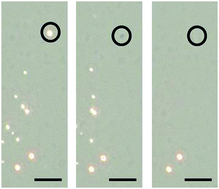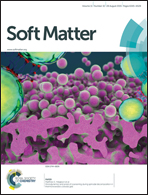Disintegration of protein microbubbles in presence of acid and surfactants: a multi-step process
Abstract
The stability of protein microbubbles against addition of acid or surfactants was investigated. When these compounds were added, the microbubbles first released the encapsulated air. Subsequently, the protein shell completely disintegrated into nanometer-sized particles. The decrease in the number of intact microbubbles could be well described with the Weibull distribution. This distribution is based on two parameters, which suggests that two phenomena are responsible for the fracture of the microbubble shell. The microbubble shell is first weakened. Subsequently, the weakened protein shell fractures randomly. The probability of fracture turned out to be exponentially proportional to the concentration of acid and surfactant. A higher decay rate and a lower average breaking time were observed at higher acid or surfactant concentrations. For different surfactants, different decay rates were observed. The fact that the microbubble shell was ultimately disintegrated into nanometer-sized particles upon addition of acid or surfactants indicates that the interactions in the shell are non-covalent and most probably hydrophobic. After acid addition, the time at which the complete disintegration of the shell was observed coincided with the time of complete microbubble decay (release of air), while in the case of surfactant addition, there was a significant time gap between complete microbubble decay and complete shell disintegration.


 Please wait while we load your content...
Please wait while we load your content...